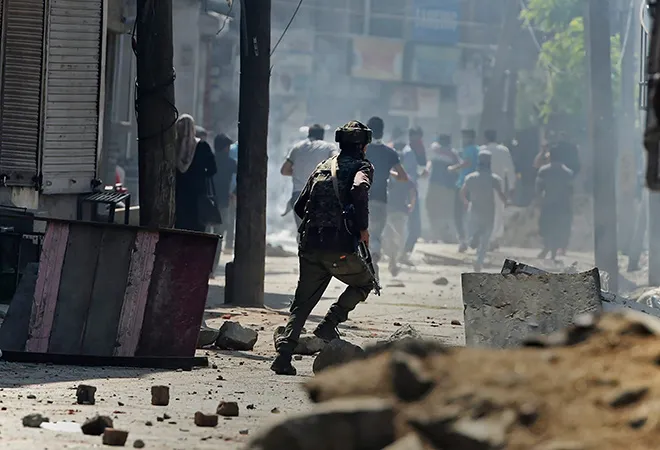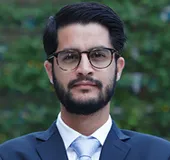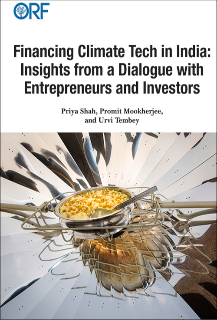
The deep state in Pakistan has orchestrated, sponsored and pushed jihadist groups against India for decades. While many security experts in India call this an asymmetrical warfare strategy, at the heart of it lies the doctrine of Jihad. Among the many jihadist outfits running from Pakistan, the Lashkar-e-Taiba (LeT), Jaish-e-Mohammad (JeM) and Harkat ul Jihad Islami (HUJI) are the main Pakistan based groups that have successfully conducted terror strikes across India, beyond the borders of the Indian state of Jammu and Kashmir.
While these Jihadist groups have often espoused fighting for the ‘cause of Kashmir’ as their raison d'être, Kashmir is used as chimera to disguise their real agenda. Using Kashmir an excuse and a digression has been a recurrent feature of many misadventures of terror groups, and an unstated policy of Pakistan. A glaring example of this policy is the Kargil misadventure of Pakistan Army, exposing its tactics of deception in the summer of 1999.
At the height of the Kargil War the official position of the Pakistan Army was to deny any direct or indirect involvement in the operation and credit the operation to the “Mujahideen” (militants fighting for ‘freedom’) of Kashmir. In fact, the same line was sold to civilian rulers of that time by the Pakistan army — such was the audacity of the group of military officers who planned the operation.
Using Kashmir an excuse and a digression has been a recurrent feature of many misadventures of terror groups, and an unstated policy of Pakistan. A glaring example of this policy is the Kargil misadventure of Pakistan Army, exposing its tactics of deception in the summer of 1999.
According to accounts that have since appeared in Pakistani media, Nawaz Sharif, the then Prime Minister of Pakistan, was kept out of the loop on the strategy to invade Kargil. General Pervez Musharraf (who later assumed power in a coup in October 1999, four months after the Kargil War) planned the operation, but his team told Nawaz Sharif that Kargil was taken over by Kashmiri militants. This conversation continued till May 1999 shortly before full scale military conflict erupted. Pakistani commentator Najam Sethi says the Generals assured Sharif there was plausible deniability in case of a strong reaction from India and potential international outrage. For the Indian government however, Kargil was decisive proof of how Pakistan and its proxies use Kashmir to create false narratives and justify aggression against India. <1>
If we analyse various large-scale terror strikes in India, most of them have been attributed to or claimed by terror groups Lashkar e Taiba, Jaish e Mohammad and HUJI. The 26/11 Mumbai attacks finally showed the world what India had been saying all along. It put the LeT on the radar of western powers, already engaged in the war on terror. Additionally, given the specific targeting of foreigners in Mumbai, international media, academia and experts began to see the LeT and its capacity to conduct spectacular attacks on Indian soil as a potent global threat.
An important aspect of groups like LeT, JeM and HUJI is that most of their activities, attacks and operations are geographically limited to the state of Jammu and Kashmir. A tiny fraction of their cadres consist of ethnic Kashmiris. In a study of 900 biographies of LeT members, a group of scholars at Combating Terrorism Center at West Point Academy in the United States, found that the majority of the LeT cadre — 89 percent is recruited from the Punjab province of Pakistan. Less than 2% came from Jammu and Kashmir. <2>
An important aspect of groups like LeT, JeM and HUJI is that most of their activities, attacks and operations are geographically limited to the state of Jammu and Kashmir.
In multiple speeches, Hafeez Saeed, the patron and ideologue of LeT has espoused the Kashmir cause as the primary motivation for his jihad against India. But this is a false narrative, aimed to make terrorists look like a group of freedom fighters. If the LeT is fighting for the cause of Kashmir then why does it attract a negligible number of recruits from Kashmir? And what business or role do Punjabi men and boys have in the “liberation of Kashmir”?
The activities of LeT, JeM and other such groups are not limited to Kashmir, the same groups are also involved in various terror attacks in mainland India. The Lashkar was behind the Red Fort attack of 2000, bombings in Delhi’s major markets in 2005, the Gurdaspur attack of 2015, and perhaps most importantly the Mumbai attack of 2008. The Masood Azhar led Jaish-e-Mohammad was behind the December 2001 attack on India’s Parliament. Each of these attacks show that the cadre of the LeT and JeM are not only involved and active in Kashmir, but are capable of conducting big terror strikes both inside and outside the state. However, both the attackers and their handlers have attempted to create different and varied, often-inconsistent narratives.
Ajmal Kasab, the only terrorist captured alive in the Mumbai attack had told the interrogators he was on ‘mission Kashmir.’ Like other Punjabi boys recruited by the LeT, Kasab was recruited in the name of ‘Kashmir cause.’ In fact, all the other terrorists involved in the Mumbai attacks were recruited and trained for Kashmir, but at the last moment, were directed to Mumbai. While these facts came out through Kasab’s exhaustive interrogation, his handlers manufactured a different narrative for the consumption of global and Indian audience. <3>
Intercepted conversations between the terrorists who attacked Mumbai, and their handlers show there was a deliberate attempt to give an indigenous spin to the strike and show domestic reasons as the primary motivation. One of the attackers in conversation with a television anchor claimed to be associated with the Hyderabad Mujahideen; group of south India. “So many Muslims were butchered. Our mosques were demolished, and we were not allowed to sleep peacefully. Our sisters and mothers were killed, why did nobody talk of surrender then? Let the commandoes come, we will make their children orphans.” And when asked about his demands, apart from the release of “Mujahedeen,” he says “yes, and also Muslims in India should not be harassed. They demolished the Babri Masjid and harass Muslims.” <4> The intercepts show that handlers tutored the terrorists to make this claim. <5>
Ajmal Kasab, the only terrorist captured alive in the Mumbai attack had told the interrogators he was on ‘mission Kashmir.’
That the LeT and JeM have a pan-Islamist ideology and and have links with global jihadist groups like Al Qaeda is well documented. These groups have also sent their cadre to fight in Afghanistan after the American intervention against Al Qaeda and the Taliban in the aftermath of 9/11 and the ensuing Global War on Terror. However, they see Kashmir as an ‘occupied land’ and therefore the nearest front for their jihad. A study done by the New America Foundation argues that LeT leaders believe after liberation Kashmir will become the base of operations to take over other parts of India. Stephen Tanker of the New America Foundation writes:
“However, it would be a mistake to suggest the group’s leaders viewed this simply as a territorial struggle. Rather, they claimed (with no regard for the historical record) that the Kashmir conflict was the latest chapter in a Hindu- Muslim struggle that has existed ever since the time of the Prophet Muhammad. Once Kashmir was liberated, they argued, it would serve as a base of operations to conquer India and restore Muslim rule to the Indian subcontinent.” <6>
So where does Kashmir fit in this larger Jihadist scheme?
Within Pakistan, the narrative on Kashmir sums up in a simplistic slogan: Kashmir is the jugular vein of Pakistan. While this narrative is exploited by the terror groups for recruitment and propaganda, it doesn’t always work in their favour. During 26/11, the narrative of persecution of Indian Muslims was exploited to highlight domestic motivations and actors as the cause. The global discourse on Islamophobia are also used to bolster these false narratives. For a short while after the 26/11 there was an attempt to delink the militancy in Kashmir with the Mumbai attacks, but that has once again turned. In recent years there has been brazen attempt to link attacks like those in Pathankot to Kashmir and portray the revival of old terror groups as a revenge.
During 26/11, the narrative of persecution of Indian Muslims was exploited to highlight domestic motivations and actors as the cause. The global discourse on Islamophobia are also used to bolster these false narratives.
Attacks inside Kashmir, like the ones in Sunjuwan and Nagrota, and the creation of the ‘Afzal Guru Squad’ after the attack on the BSF camp in Srinagar in 2017 also indicate that revival. The Afzal Guru Squad is simply Jaish-e-Mohammad by another name. <7> If the footprint of JeM had faded post 26/11, it now uses the hanging of Afzal Guru as reason for its resurgence, encashing on a sympathy wave for Guru. Afzal Guru, was convicted for his role in the 2001 attack on India’s parliament and was subsequently hanged ahead of his scheduled turn on death row.
After 26/11, the sole focus of the media in India shifted to Hafeez Saeed and LeT — so much so that any conversation on Pakistan was incomplete without a mention of Saeed. But the singular focus on Saeed and demands to bring him to justice as the mastermind of 26/11 relegated Masood Azhar to the background- to India’s detriment. Azhar Masood and Jaish-e-Mohammad rose once again in a new avata, with a new narrative, targeting security and military installations. In 2018, another Pakistan based group Al Badr has begun to conduct low intensity grenade attacks in Kashmir. The group was actively fighting against the Soviet Union in 1990’s before shifting its focus to Kashmir.
From Kargil to 26/11 and to the recent attacks on military camps, we see a dynamic shift. Kashmir will be used as a cause and an excuse when it suits the policy of Pakistan. When the environment is conducive for talks, Pakistan’s deep state chooses not to be spoiler when it comes to the dialogue process; Kashmir is downplayed in conversations on 26/11 and terrorism. <8> However, in times like these, when Indo-Pak ties seem to have gone into deep-freeze, Kashmir has returned in the discourse as Pakistan’s causus belli. Therefore, even though Pakistan might constantly adapt its responses, it is imperative for India not to lose sight of this, even as it continues to seek global censure for Pakistan as a state sponsor of cross-border terror.
<1> Nasim Zehra, “The Making of the Kargil Disaster”, Dawn, 2 July 2018. (accessed on 17 October 2018)
<2> Don Rassler, C. Christine Fair, Anirban Ghosh, Arif Jamal and Nadia Shoeb, “The Fighters of Lashkar-e-Taiba: Recruitment, Training, Deployment and Death”, Combatting Terrorism Center at West Point (2013). (accessed on 20 October 2018)
<3> C. Unnikrishnan, “Kasab Thought He Was on Mission Kashmir”, Economic Times, 5 January 2009. (accessed on 17 October 2018)
<4> “26/11 Tape: Terrorist Talks to TV”, The Hindu, 25 June 2012. (accessed on 17 October 2018)
<5> “26/11 Tape: Zabiuddin Ansari Briefs Terrorists”, The Hindu, 25 June 2012. (accessed on 17 October 2018)
<6> Stephen Tankel, “Lashkar-e-Taiba: Past Operations and Future Prospects”, New America Foundation, 27 April 2011. (accessed on 20 October 2018)
<7> Azhar Qadri, “JeM's Afzal Guru Squad Strikes Again”, The Tribune, 11 February 2018. (accessed on 18 October 2018)
<8> Manan Dwivedi, “Cross Border Terrorism: Irritants in Indo-Pakistan Relations”, Indian Journal of Asian Affairs 21, no. 1/2 (2008) pp 31-53. (accessed on 18 October 2018)
The views expressed above belong to the author(s). ORF research and analyses now available on Telegram! Click here to access our curated content — blogs, longforms and interviews.




 PREV
PREV


